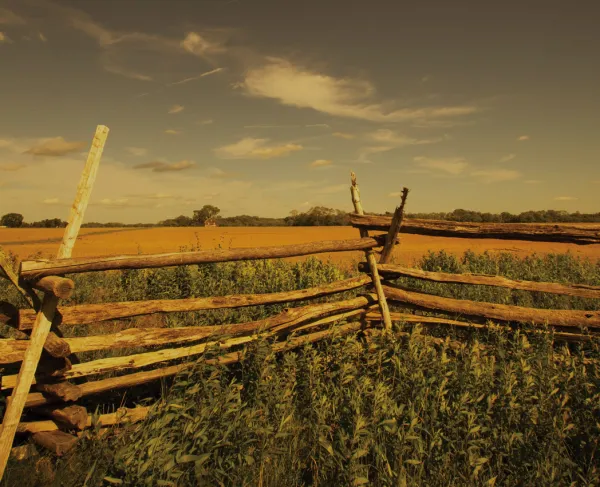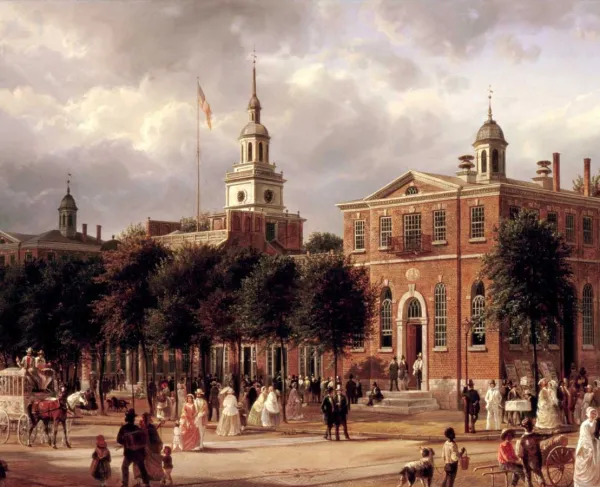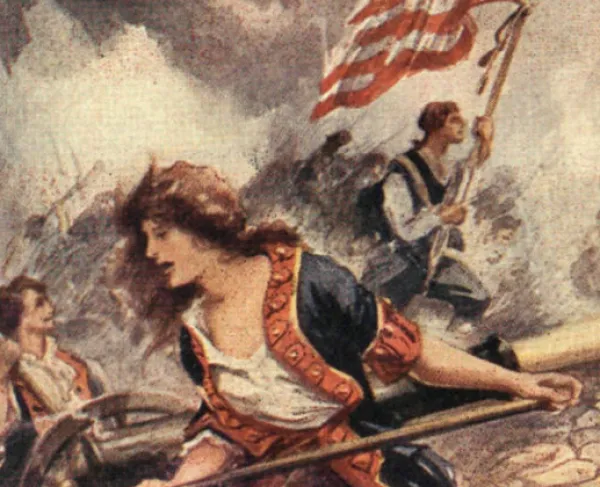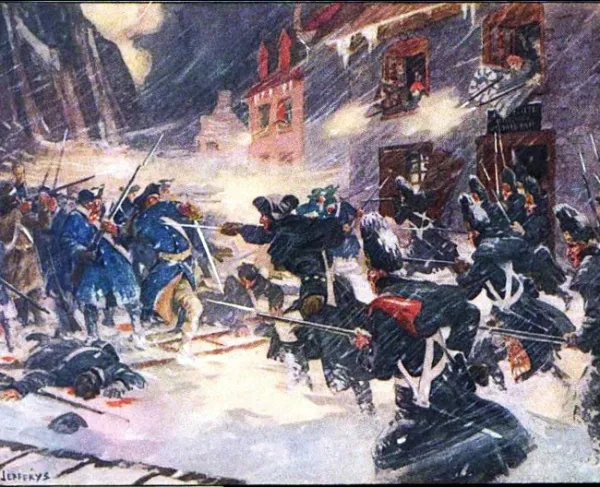
The Point of Woods at the Monmouth Battlefield State Park, Monmouth County, N.J.
June 1778: The Continentals had an extraordinary opportunity as the British Army withdrew from Philadelphia to New York. If they survived the sweltering heat, might they still squander it?
“Huzza! Long live the king of France!”
The cheer went up from 14,000 Continental soldiers at Valley Forge on May 6, 1778, celebrating the Treaty of Alliance that openly brought France into the war, after clandestinely aiding the American cause for a year.
Twenty miles away, and just shy of two weeks later, the British army in Philadelphia had its own gala celebration to bid farewell to commander-in-chief Sir William Howe. Into his place stepped Sir Henry Clinton, the mastermind behind the flanking maneuver that nearly doomed the Continental Army at the Battle of Long Island in August 1776. Clinton favored more aggressive measures to bring the Americans to heel, but any notions of grand offensives under his command were short-lived.
In early May, secret instructions from London drastically changed the British grand strategy. With France now in the war, it was the “Will and Pleasure” of the king that Clinton “evacuate Philadelphia, and having embarked all the Troops, as also the Ordnance, Stores, Provisions, & every thing belonging to Us, or necessary for Our Troops,” he was to “proceed with the whole to New York.” While maintaining a sizable presence in that city, the primary military focus would now be on bringing the southern colonies back into the fold and defending British possessions in the West Indies against French attack.
With too few ships available for a total seaborne evacuation, the Royal Navy would furnish transportation for the heavy guns, ordnance and quartermaster stores and the sick and wounded, as well as Loyalist refugees fleeing Philadelphia. Clinton would have to lead the army by land across New Jersey.
Back at Valley Forge, with the British evacuation well underway, Washington convened a Council of War on June 17. There was little consensus except to avoid a general engagement at all costs. By the next day, the window for deliberation had closed. The Crown forces, approximately 20,000 strong, including the women and children attached to the army, had crossed the Delaware River and were moving north. Washington had to act.

Three Continental brigades — those of Generals Jedediah Huntington, Enoch Poor and James Varnum — were ordered to march at 3:00 p.m. on the 18th, under the command of General Charles Lee, who had only recently returned to the army after his capture in December 1776. Two hours later, General Anthony Wayne was dispatched with three additional brigades of Pennsylvania troops. Together, Lee and Wayne crossed the Delaware and establish a camp in New Jersey. The rest of the army followed the next day — they had a “dangerous glorious race to run” to catch Clinton.
Luckily for Washington, Brigadier General William Maxwell’s New Jersey Brigade was advantageously stationed to slow Clinton. Portions of the brigade had already been posted in southern Jersey since March to guard against any British foraging incursions. Now, bolstered by new nine-month levies, along with between 1,300 and 2,000 of their comrades in the Jersey militia, the Jerseymen set to making the British advance as difficult as possible by felling trees and skirmishing at every opportunity. Sizable engagements were fought on June 23 between the militia and British troops at Bordentown and Crosswicks.
June 24 was a day of decision for both armies. For Clinton, Allentown was a literal crossroads. The shortest route to New York was north to New Brunswick and across the wide Raritan River, then east along the Post Road. However, this not only would take the army through a largely Whig area of the state with an active and veteran corps of militiamen ready to pounce, it also presented a major logistical challenge. The British baggage train consisted of approximately 1,500 wagons, but only two bridges spanned the river at Brunswick and Raritan Landing.
Instead, Clinton opted for the longer, though safer, eastward route through Monmouth County to Sandy Hook, a peninsula that jutted into New York Harbor. Making for Sandy Hook would extend Clinton’s march by several miles and involve a more intensive transport role by the Royal Navy to bring the army to New York, but it would be through more-friendly territory.
Meanwhile, 25 miles away at Hopewell, N.J., Washington convened a second Council of War. All in attendance again agreed that there should be no general action, and Lee even went so far as to insist that they allow Clinton to march unopposed across New Jersey. A future allied Anglo-French operation would surely be more successful than a small demonstration now. Nevertheless, a detachment of 1,500 Continentals under General Charles Scott would be dispatched to aid Maxwell in harassing the British march, while the main body would keep its course and “act as circumstances may require.”

Washington was disappointed. To allow the British to cross into New Jersey unopposed would be seen as both a political and military disaster. A demonstration of some sort had to be made, not only for the reputation of the army, but, perhaps most importantly, for the reputation of Washington as commander in chief. Doubts over Washington’s fitness for command had swirled since the string of defeats in New York in the summer and fall of 1776, and they came to a head after the loss of Philadelphia, with a small cabal of officers clamoring to replace Washington the victor of Saratoga, General Horatio Gates.
Shortly after the council adjourned, several officers, including the Marquis de Lafayette, Wayne and Nathanael Greene, reconsidered their conservative approach. “People expects [sic] something from us & our strength demands it,” Greene wrote. “I am by no means for rash measures, but we must preserve our reputation.” Buoyed by this support, Washington called for another detachment of 1,000 men to be sent forward under Wayne.
General Charles Lee was offered command but turned it down, and it was instead tendered to the Marquis de Lafayette. However, in his zeal to close quickly with the enemy, Lafayette drove his men to near exhaustion beyond the reach of the main body to support them before they had made contact with Clinton. The eager subordinate needed to be reined in, and Lee was sent forward with two additional brigades to rendezvous with Lafayette at Englishtown, where Lee would then take overall command. This Continental vanguard now numbered approximately 4,500 men, nearly a third of the army, and it was within striking distance of the Crown forces.
Sunday, June 28, 1778, dawned sweltering, the humidity worsened by heavy thunderstorms the night before. Lee began his advance by 5:00 a.m., though he hadn’t yet formulated a plan of attack, and the intelligence he was receiving was piecemeal. His final orders from Washington were to “annoy the enemy as much as in [your] power, but at the same time proceed with caution and take care the Enemy don’t draw [you] into a scrape.”
British troops and baggage were moving out of the village of Monmouth Courthouse, also known as Freehold, toward Middletown. As Lee’s vanguard drew nearer to Monmouth Courthouse, the tactical situation became clearer. He now wanted to cut off the British rear guard, which he estimated to be about 500 light infantry and dragoons, in a neat little action. However, shortly after contact was made at approximately 9:30 a.m., Clinton began to counterattack in force, recalling his best troops to the fray, including the Guards and Grenadiers.
Lee’s attention was focused on the right wing of his vanguard, deployed in the open, rolling plains just west of Monmouth Courthouse, where the British counterattack led by General Charles Cornwallis was bearing down. In the dark as to Lee’s plans and under the building pressure of the British force to its front, the left wing began to withdraw to safer ground to the west. On the right, Lafayette also started to pull back.
Communication was breaking down, and Lee was losing control of the situation. With Cornwallis bearing down on him, he had no choice but to order a retreat.

By this time, the main body of the Continental Army was passing the white clapboard Tennent Presbyterian Meeting House, about four miles west of Monmouth Courthouse. Washington rode ahead to assess the situation, and was surprised to be met with confused men and officers streaming back toward Englishtown. It was now obvious that Lee’s attack had failed, and Washington needed to know why. He rode forward and, as one Continental later remembered, Washington called out to Lee, “What is this you have been about to day?” Lee, stammering at first, replied that he had no choice but to retreat. Washington was having none of it.
It was now about 1:00 p.m., and with Clinton bearing down on the disorganized Continentals, Washington had 15 minutes to stabilize the situation. He ordered Colonel Walter Stewart and Colonel Nathaniel Ramsey’s battalions of picked men, as well as a consolidated Virginia regiment forward into a “Point of Woods” to delay the British advance. One of these picked men was 21-year-old Solomon Parsons, drawn from Colonel Timothy Bigelow’s 15th Massachusetts. He managed to fire three shots before he was forced to flee. “I wheeled to the left,” Parsons recalled, “and observed that the enemy had flanked our men, which were out of the woods. I got ten rods, and the enemy… fired a platoon upon me. One ball struck my heel, which much disabled me. The next platoon on the left fired on me, and broke my thigh.” As he was overtaken by the enemy, Parsons was also bayonetted, clubbed and, to add insult to injury, had his watch, canteen of rum and wallet stolen, before he was left for dead in the scorching 96-degree heat.
As the brief fight at the Point of Woods was underway, Washington looked to Lee to organize further delaying positions while he supervised the deployment of the main American position. Lee positioned Varnum’s brigade and a battalion under Henry Livingston along a hedgerow and fence line about a half mile to the west of the Point of Woods that guarded the approach to a bridge over the West Morass, across which the main American position was coming onto line on high ground called Perrine Ridge. Survivors of the Point of Woods filtered through the hedgerow, as the Guards and 1st and 2nd Battalions of Grenadiers “pushed on briskly with their Bayonets, which … they did with true British spirit.” They were spurred along by General Clinton himself, who was “galloping like a Newmarket jockey at the head of a wing of Grenadiers” shouting, “Charge Grenadiers! Never heed forming!” Varnum and Livingston opened the fiercest firefight of the battle, supported by two pieces of artillery firing grapeshot through the breaches in the wooden fence.
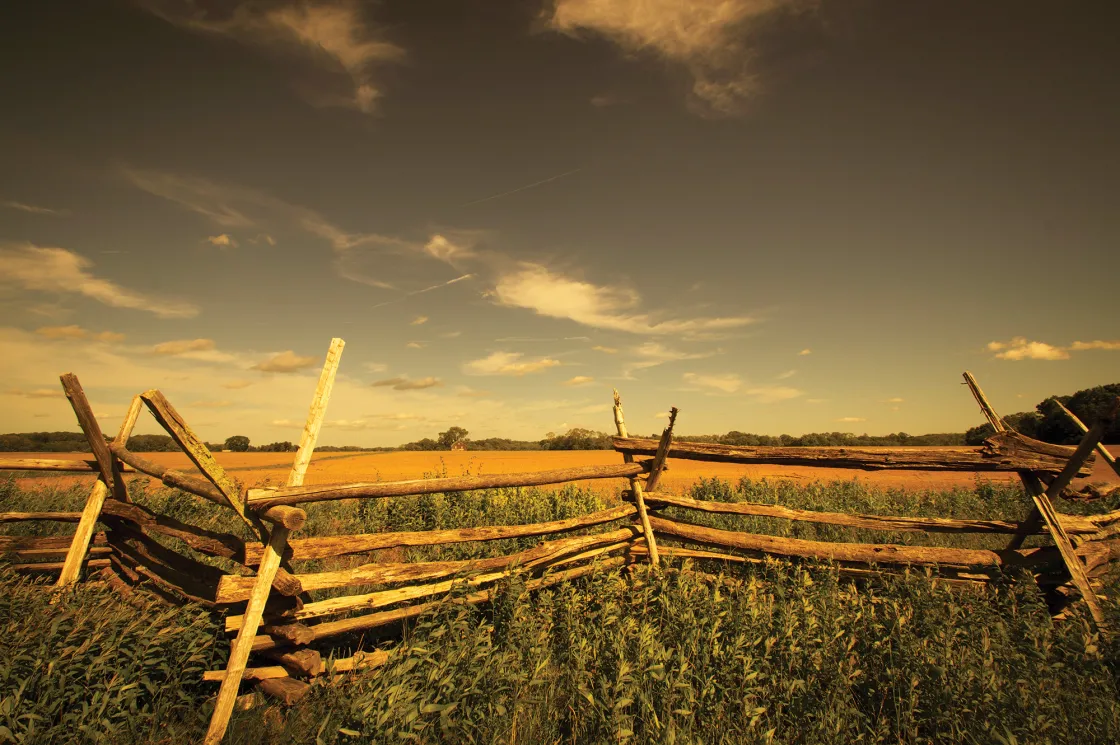
The action at the hedgerow was sharp and quick, lasting only a few volleys before the Americans disengaged and made a quick but orderly retreat across the bridge at West Morass to the safety of the American line. Grenadiers pursued the retreating Americans across the bridge, but as they crested a small rise approximately a few hundred yards later, they were swept by canister and musketry from Perrine Ridge.
It was now time for General Henry Knox and the Continental artillery to take center stage, with a counter-battery exchange involving approximately 16 guns arrayed along Perrine Ridge firing solid shot. The British returned fire with both solid shot and timed exploding rounds from two howitzers that joined the 14 pieces of the Royal Artillery deployed on a height just west of the hedgerow. British gunners, however, were cutting their fuses just a little too long, causing the shells not to burst overhead as intended, but instead on the ground and among the rail fences just below the artillery line where the Continentals were taking cover, wounding several from flying wooden splinters.
For most of the afternoon, the guns roared in what Colonel Henry Dearborn thought was the “finest music” he had ever heard, “yet the agreeableness of the musick was very often Lessen’d by the balls Coming too near.” Also taking cover with the infantry was Connecticut soldier Joseph Plumb Martin, who turned to watch the guns in action behind him and saw “a woman whose husband belonged to the artillery and who was then attached to a piece in the engagement, attend[ing] with her husband at the piece the entire time” bringing forward ammunition to the gunners. Tradition holds that this woman was Mary Hays, the wife of William Hays, an artilleryman in the 4th Continental Artillery Regiment, and who went by the nickname “Molly Pitcher” from her role as a water carrier for the parched men of the battery.
As the Continentals hugged the ground waiting out the cannonade, Washington rode “to and fro along the line, sometimes at full speed, looking nobly, excited, and calling loudly to the troops by the appellation of brave boys.” The surprise arrival of an American brigade under General Nathanael Greene with four guns commanded by French Brevet Lieutenant Colonel Thomas Antoine, Chevalier de Mauduit du Plessis on Comb’s Hill, a prominent height less than a half mile from the British left flank, opened the hedgerow line to enfilade artillery fire, causing Clinton to withdraw.

As the British artillery fire eased, Washington’s attention was directed on Colonel Thomas Proctor’s battery, whose men were throwing canister into an apple orchard approximately 500 yards to their front. Earlier in the morning, as the American vanguard was falling back from Freehold, the British 3rd Brigade under Major General Charles Grey, including the 42nd Royal Highland Regiment, gave chase to General Charles Scott’s detachment across the farm of John Craig just to the north of the Point of Woods. The timely arrival of Knox’s artillery coming onto line on Perrine Ridge stopped the advance of the 3rd Brigade, and its men were forced to take cover in a swale behind a cider orchard on Derick Sutphin’s farm, with the 42nd in the forward position among the apple trees.
By now, nearly eight hours after making first contact, Clinton realized that the American position was too strong and he’d be unable to deliver a knockout punch to Washington in a general engagement. Back on Perrine Ridge, Washington could see that the British were beginning to pull away and ordered Wayne to probe whatever enemy troops were still near the hedgerow. Cornwallis drove Wayne back into the farmhouse and barnyard complex of the Tennent Parsonage. Du Plessis sprang his guns on Comb’s Hill back into action, once again delivering enfilading canister shot into the British left flank and forcing them to retreat back toward Freehold.
Near dusk, American pickets advanced east toward the Point of Woods. On the rising ground beyond the Kerr Farm lane, they found Solomon Parsons, who, after more than seven hours of lying out on the field, had not yet succumbed to his wounds. He was brought back to the field hospital established at the Tennent Meeting House.
That night, the American troops bivouacked on their arms on the battlefield, expecting the action to renew in the morning. Clinton, however, took a page from Washington’s playbook and, come morning, the British army was gone. By Clinton’s official report, the “engagement at the Heights of Freehold” cost him 65 killed, 140 wounded and 64 missing, with an additional 59 dead “with fatigue,” though Washington reported finding 249 officers and rank and file dead on the field.
The price for the Americans at Monmouth was 69 dead, 161 wounded and 140 missing. For the first time since Princeton, the Continental Army could credit itself with a successful battlefield performance. For many, Monmouth would be a day they would never forget, either because of the brutal heat or because of the wounds they were left with. Solomon Parsons survived until 1831, “suffering,” according to his monument, “53 years from a wound received at Monmouth Battle, where he bled for his Country. Reader, pause, recollect what it cost to gain your liberty.”
